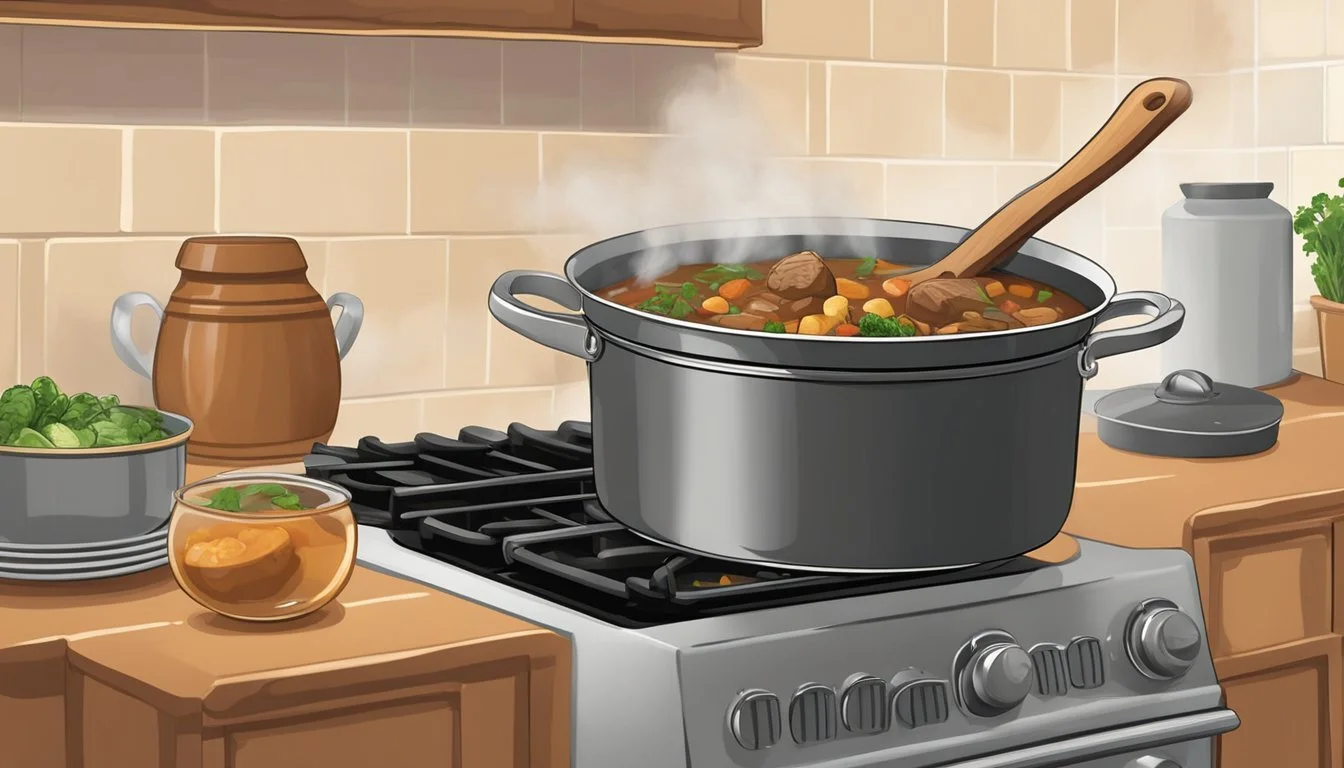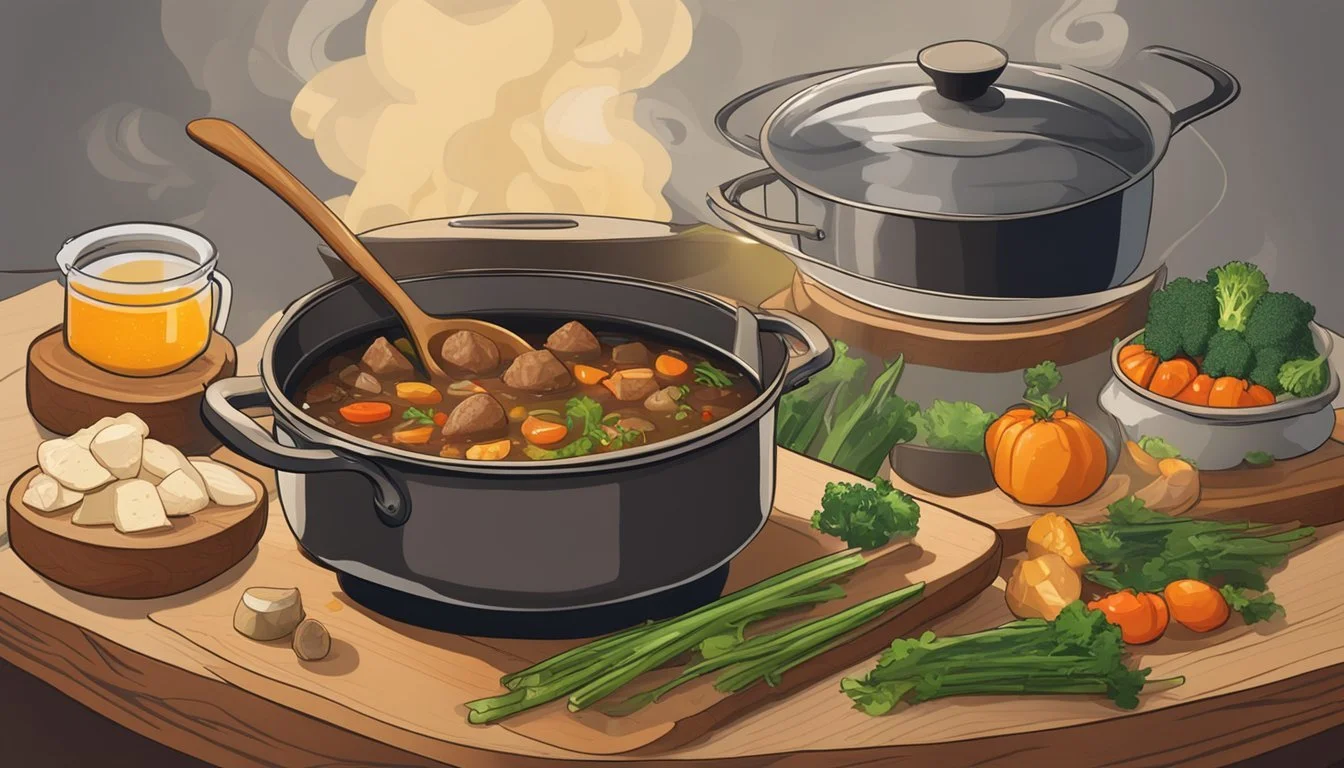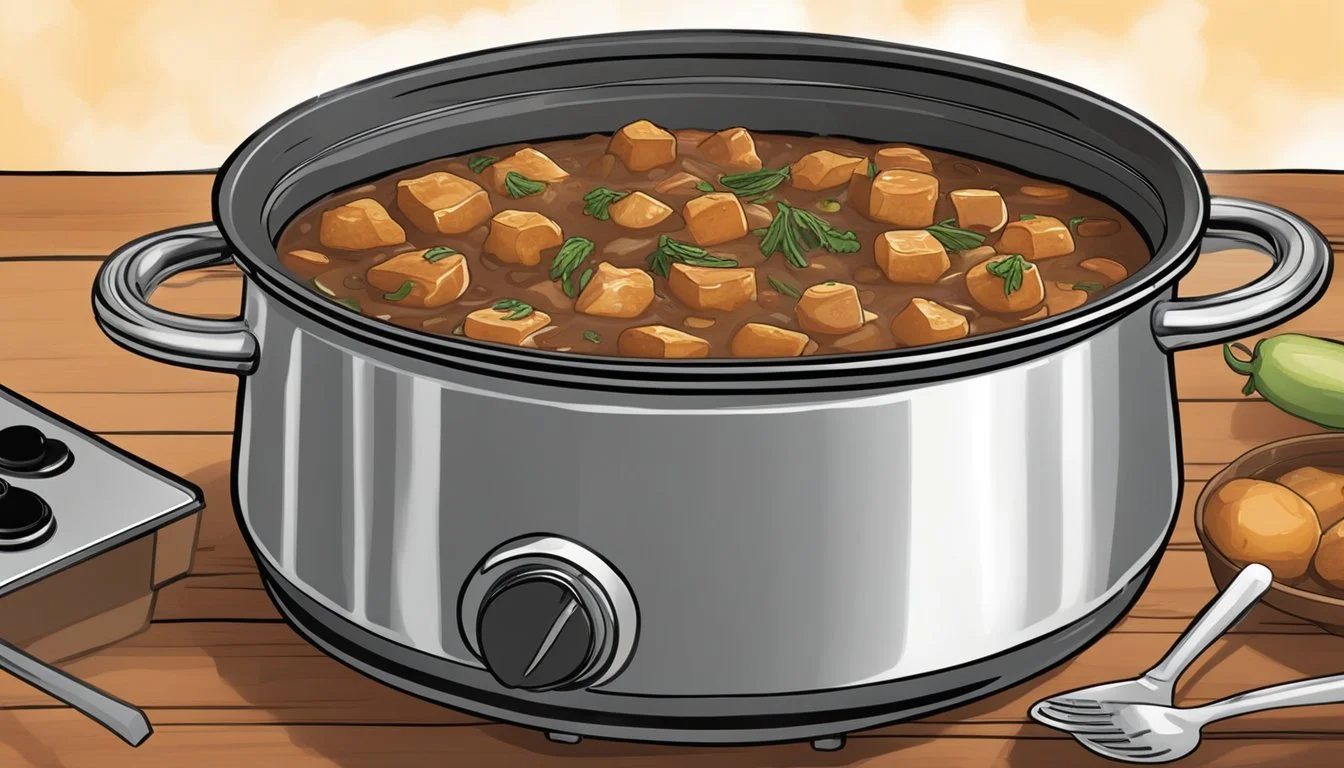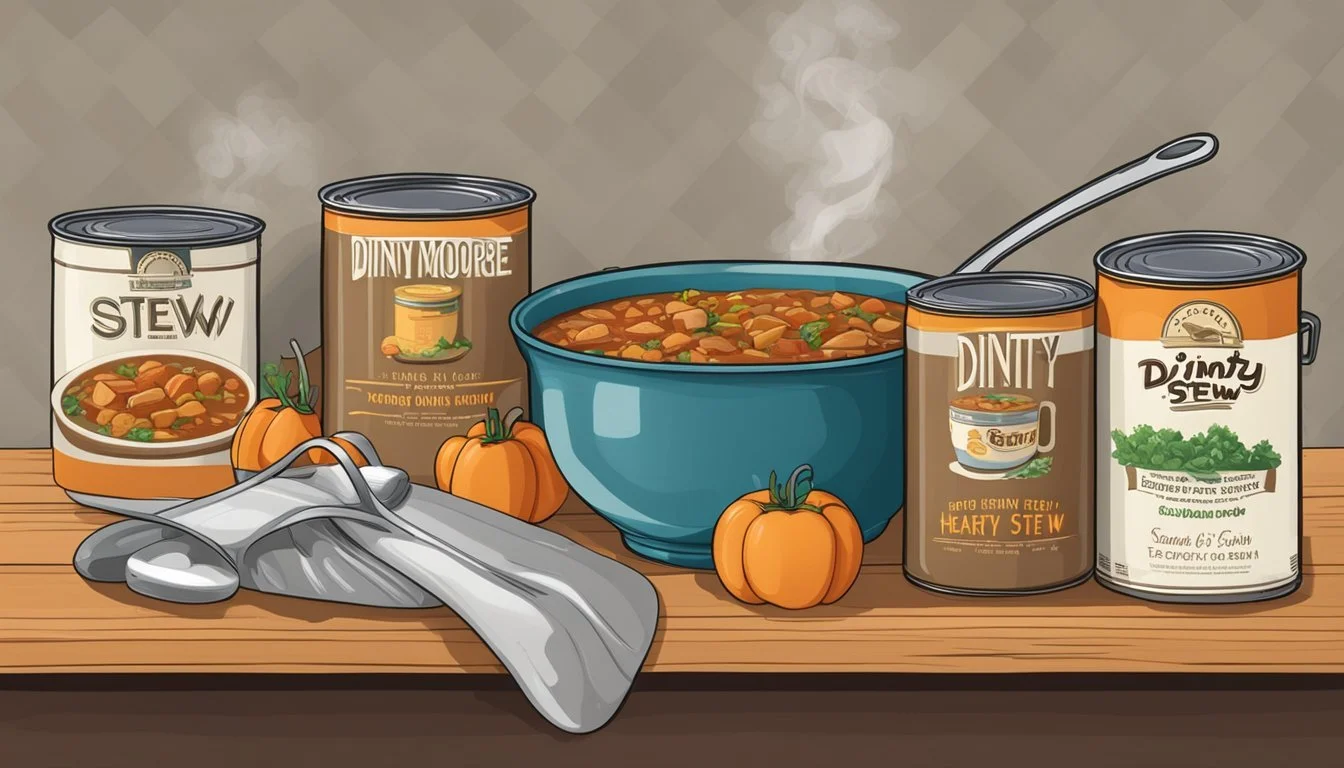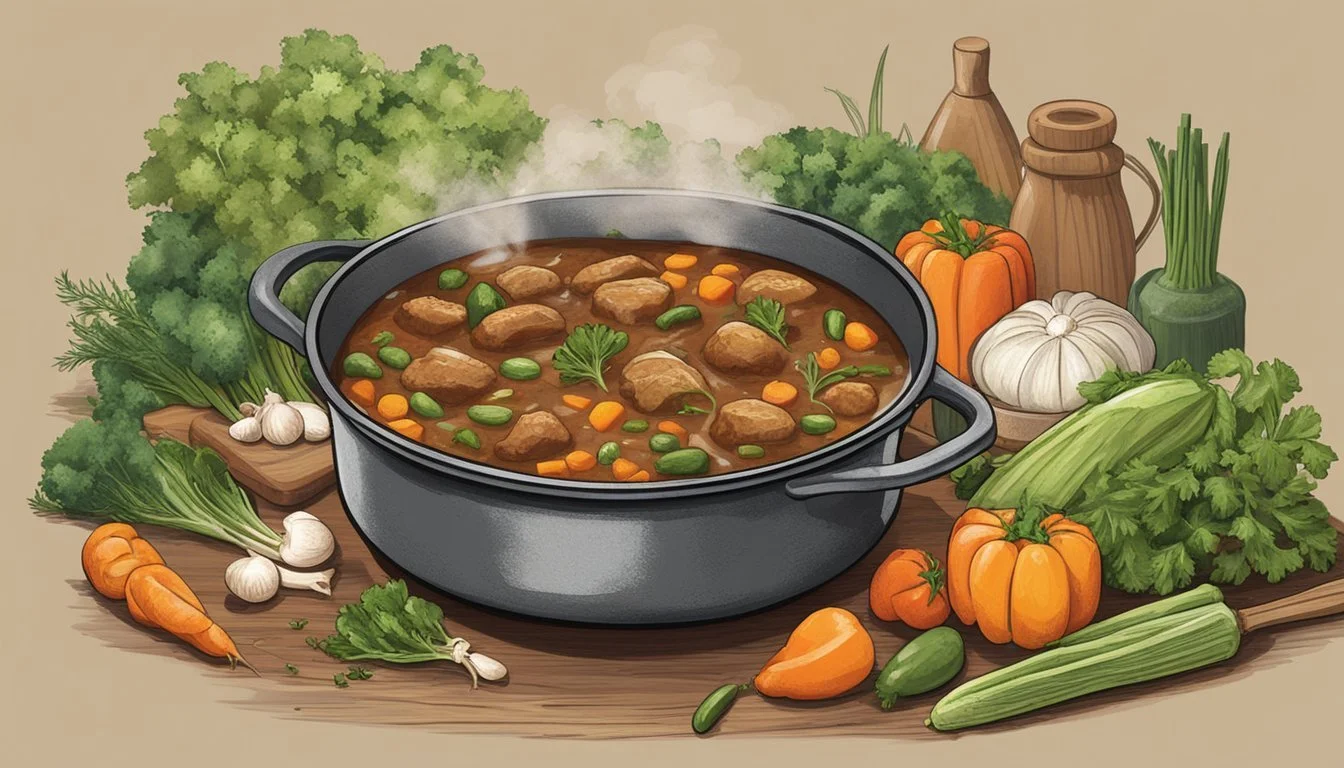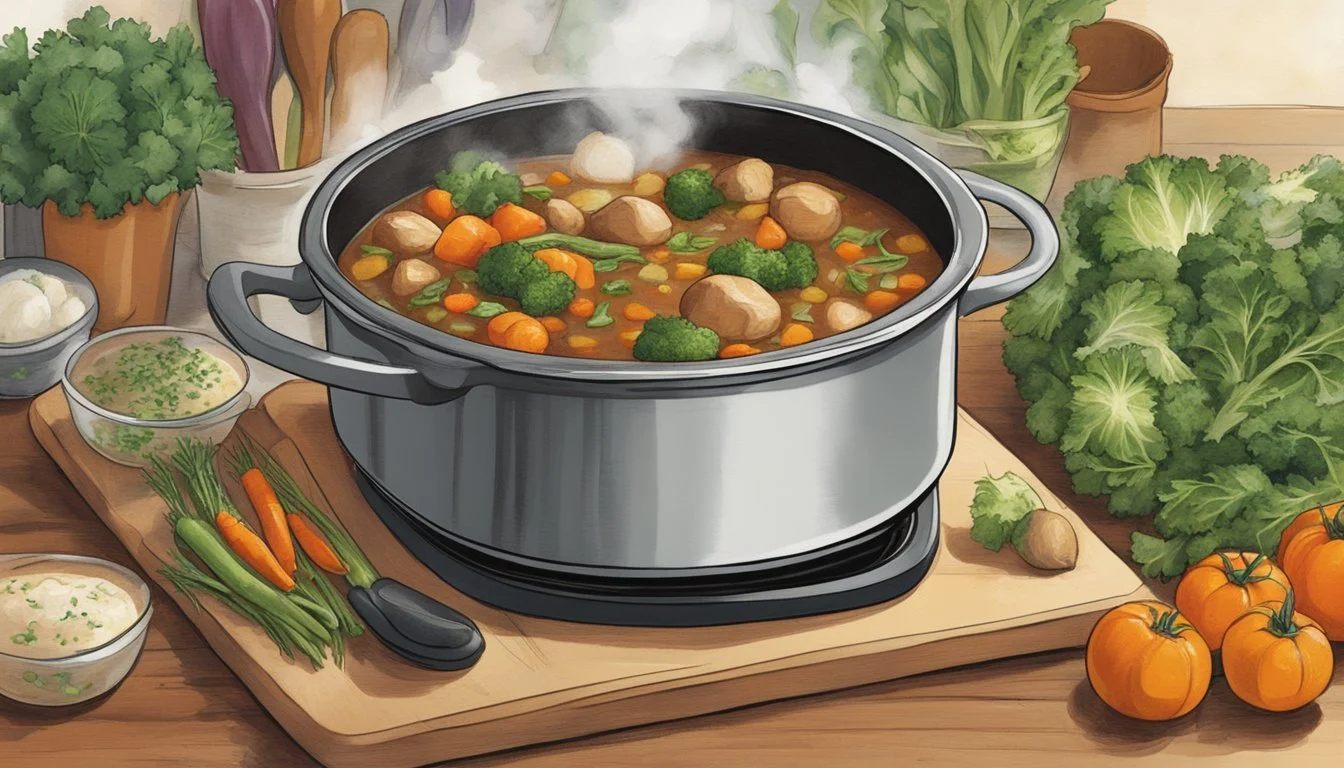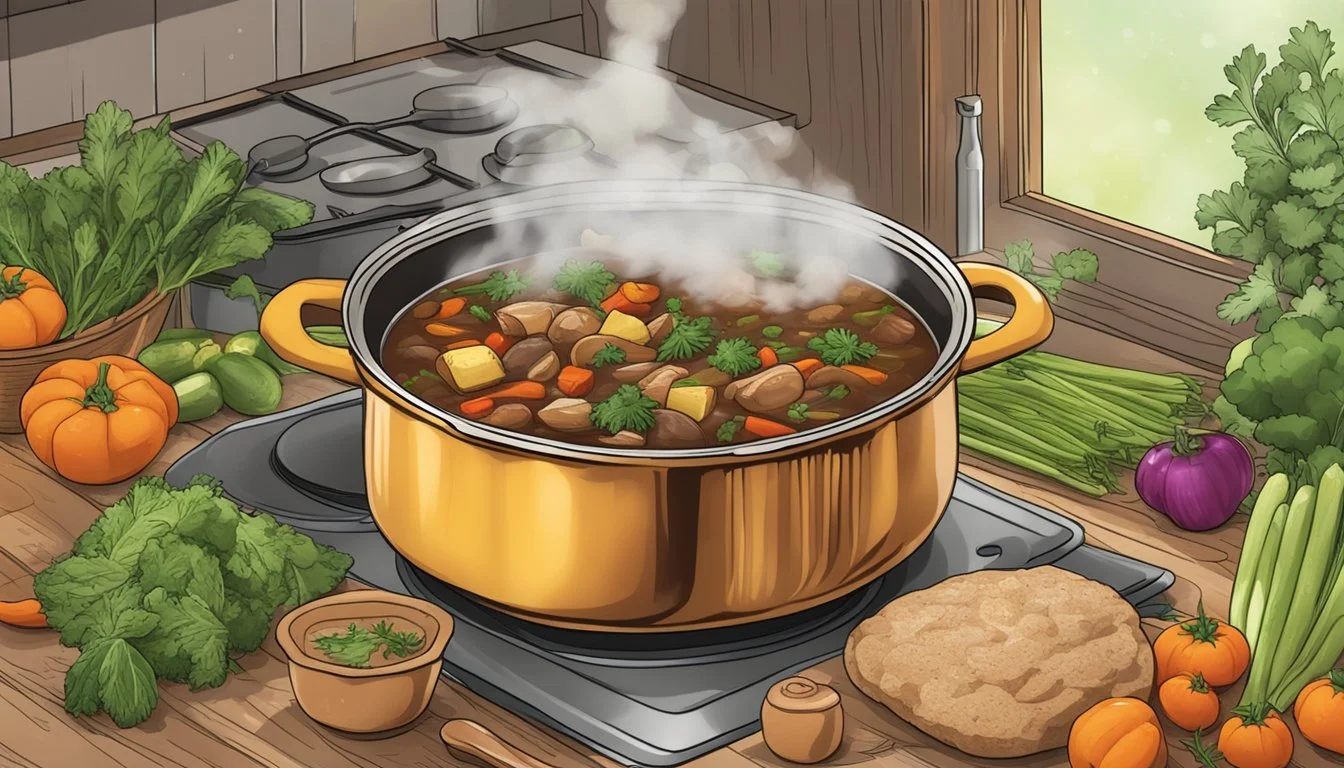How to Cook with Dinty Moore Stew
Hearty Dinners Made Easy
Dinty Moore Beef Stew (What wine goes well with beef stew?) offers a convenient foundation for a variety of hearty dinners (What wine goes well with dinner?) that evoke the comfort and homeliness of traditional home cooking. With its pre-cooked beef and vegetable components, Dinty Moore is a time-saver for those seeking to prepare a satisfying meal without the lengthy preparation typically involved in making stew (What wine goes well with stews?) from scratch. Its ready-to-eat nature makes it a versatile ingredient for creative cooking, allowing for enhancement and customization to suit one's taste preferences.
Although Dinty Moore Beef Stew is designed to be enjoyed straight out of the can, its flavors can be amplified and transformed into something even more special with a little culinary ingenuity. The thick gravy and chunks of meat and vegetables lend themselves well to augmentation with additional herbs, spices, and ingredients, transforming a simple can of stew into a dish with greater depth of flavor. Cooks may choose to supplement the stew with freshly sautéed onions and garlic or to incorporate a touch of Worcestershire sauce for added umami.
For those seeking comfort food without the time investment of slow-cooking, incorporating Dinty Moore into recipes can provide that desirable home-cooked taste. The stew makes an excellent starting point for pot pies, casseroles (What wine goes well with casseroles?), and even as a filling for baked potatoes. By employing Dinty Moore Beef Stew as the main ingredient, these dishes not only become more accessible and less time-consuming but also maintain the rich, robust flavor profiles that are characteristic of a meal made with patience and care.
Understanding Dinty Moore Stew
Dinty Moore Stew is a brand of canned beef stew known for its convenience and heartiness. This section provides insights into its origins, ingredients, and nutritional profile.
History and Background of Dinty Moore
Dinty Moore stew was introduced to the American market in 1935. It gained recognition as a reliable and fulfilling meal solution, becoming synonymous with simplicity and comfort for busy families and individuals. The stew has maintained its presence in the market for decades, appealing to those seeking a quick, traditional beef stew.
Key Ingredients in Dinty Moore Beef Stew
The primary components of Dinty Moore beef stew are as follows:
Protein: Hearty beef chunks form the staple protein base.
Vegetables: Potatoes and carrots add natural sweetness and texture.
Flavorings: Onions, salt, and pepper provide the fundamental flavor profile.
Liquid: Water and beef broth create the stew's base, with Worcestershire sauce adding a savory depth.
Herbs: Thyme and bay leaves are common herbs that infuse the stew with aromatic undertones.
Each ingredient plays a vital role in creating the stew's distinctive taste.
Nutritional Information and Dietary Considerations
Understanding the nutritional content is crucial for dietary planning:
Nutrient Amount per Serving Calories Varies by serving size Total Fat Varies by serving size Saturated Fat Varies by serving size Trans Fat Varies by serving size Cholesterol Varies by serving size Sodium Varies by serving size Total Carbohydrates Varies by serving size Dietary Fiber Varies by serving size Sugars Varies by serving size Protein Varies by serving size Vitamins & Minerals Varies by serving size
It's important for consumers to review the product label for specific nutritional information and to consider any dietary restrictions or preferences. The stew is generally high in protein but may also be high in sodium, which should be monitored as part of a balanced diet.
Preparation Basics
Dinty Moore Beef Stew serves as a robust and convenient base for a hearty meal. Knowing the preparation fundamentals ensures a satisfying dining experience.
Serving Suggestions
One can serve Dinty Moore Beef Stew straight from the pot, ensuring it's transferred into a pre-warmed bowl to maintain its temperature. A sprinkle of fresh parsley or chives adds visual appeal and a burst of fresh flavor.
Proper Heating and Serving Temperatures
Heat the beef stew in a saucepan over medium heat until it reaches a gentle simmer. The ideal serving temperature for the stew is approximately 165°F to 175°F, which is hot enough to ensure a flavorful experience without being uncomfortably hot.
Accompaniments and Sides
Dinty Moore Beef Stew pairs well with a variety of sides. Here are some classic options to consider:
Starches: Mashed potatoes, rice, or a slice of crusty bread for sopping up broth
Vegetables: Steamed green beans or sweet potatoes provide a nutritious and colorful contrast
Salad: A crisp green salad dressed with a vinaigrette balances the richness of the stew
Cooking Techniques and Recipes
This section details how to integrate Dinty Moore beef stew into various recipes, personalize the dish with custom flavor variations, and craft a homemade stew inspired by this hearty product. Practical cooking techniques are highlighted to ensure delicious results.
Incorporating Dinty Moore into Your Own Recipes
Dinty Moore beef stew can serve as a versatile base for a variety of comforting meals. It can be thickened with flour or cornstarch for a more robust consistency or augmented with additional beef broth to extend the dish if needed. A simple method is to sauté extra vegetables like celery or sweet potatoes in vegetable oil and blend them into the stew to expand its volume and nutritional content.
Variations for Customization
With a few ingredient adjustments, one can easily customize Dinty Moore's stew to accommodate different tastes. Adding spices such as rosemary or thyme can infuse the stew with aromatic flavors. For a more personalized touch, they can try incorporating a mix of fresh herbs and seasonings like salt and pepper, catering to their preferred flavor profile. The versatility of the stew allows for rich personalization, from stirring in roasted tomatoes for acidity to adding other root vegetables for added texture.
Making Homemade Beef Stew Inspired by Dinty Moore
Emulating the rich taste of Dinty Moore stew in a homemade version involves simmering choice beef chunks with a blend of traditional seasonings and root vegetables. First, browning the beef in vegetable oil ensures a deep flavor. A classic base of flour and beef stock, thickened with cornstarch if desired, creates a satisfying gravy-like consistency. Simmering this combination allows the flavors to meld together, resulting in a stew that is both hearty and reminiscent of the comforting Dinty Moore product.
Cookware and Utensils
Selecting the appropriate cookware and utensils is essential to ensure the preparation, serving, and storage of Dinty Moore stew is practical and maintains its quality. These tools can influence cooking times, flavor, and presentation.
Recommended Pots and Pans for Stew
For preparing Dinty Moore beef stew, one should utilze a heavy-duty saucepan or Dutch oven. Here are ideal choices:
Cast Iron Dutch Oven: Retains heat well, ideal for simmering stew.
Stainless Steel Pot: Durable and easy to clean.
Serving Cutlery and Dishes
When serving beef stew, the correct dishes and cutlery enhance the dining experience.
Bowls: Deep ceramic bowls retain heat well.
Spoons: Large, flat-bottomed spoons are perfect for hearty bites.
Storage Containers for Leftovers
To store any remaining stew, consider the following:
Glass Containers: Microwave-safe and seals in freshness.
Freezer-Safe Containers: Essential for long-term storage.
Specialty Gadgets for Advanced Techniques
For those wishing to enhance their beef stew, certain gadgets might be helpful.
Measuring Spoons: Precise herb and spice addition.
Ladle: Efficient way to serve stew over a baked potato.
Advanced Cooking Methods
Employing advanced cooking methods allows one to elevate the humble can of Dinty Moore Beef Stew into a meal that's both comforting and impressive. By adapting the stew to slow cookers, converting it into casseroles, or transforming leftovers into entirely new meals, one unlocks a new dimension of culinary convenience and flavor.
Slow Cooker Adaptations
When adapting Dinty Moore Beef Stew for the slow cooker, the key is low and slow cooking. This method allows the flavors to meld together and intensifies the savory notes of the beef. Here's a simple guide:
Layer Ingredients: Begin by placing vegetables like carrots and potatoes at the bottom of the slow cooker.
Add the Stew: Pour the Dinty Moore Beef Stew over the vegetables.
Season: If desired, sprinkle in extra herbs like thyme or rosemary.
Cook: Set the slow cooker on low for 6-8 hours or high for 3-4 hours.
Casserole Conversions
A casserole version of Dinty Moore Stew brings a delightful twist to the dinner table. Converting the stew into a casserole often involves the addition of a starchy component and cheese. Here's a quick rundown:
Preheat Oven: Heat your oven to 375°F (190°C).
Combine: In a baking dish, mix the stew with additional vegetables or cooked pasta.
Top with Cheese: Sprinkle grated cheddar or another preferred cheese on top.
Bake: Place in the oven for about 25-30 minutes until bubbling and golden.
Transforming Leftovers into New Meals
Leftover beef stew offers a fantastic base for creating new dishes such as a beef stew pot pie. Here's how one can transform yesterday's stew:
Prep the Pie Crust: Roll out a pie crust and place it in a pie dish, or use store-bought for convenience.
Fill: Spoon the leftover Dinty Moore Stew into the crust.
Top and Seal: Cover with another layer of crust, sealing the edges.
Bake: Bake in a preheated oven at 400°F (204°C) for 30-35 minutes or until the crust is flaky and golden brown.
Seasoning and Flavor Enhancements
Carefully chosen seasonings and flavor enhancements can transform a simple can of Dinty Moore beef stew into a richer, more complex dish. It is important to select the right combination of spices and herbs and to incorporate umami-boosting ingredients to elevate the pre-made stew to a home-cooked taste.
Balancing Spices and Herbs
Adding herbs such as rosemary and thyme imparts a fragrant depth to the stew, while a touch of parsley offers a fresh finish. A balanced use of salt and pepper is vital; they are the essential seasonings that intensify the natural flavors of the beef and vegetables. Consider these carefully measured additions to enhance the stew:
1 tsp dried thyme or 2 tsp fresh thyme leaves
½ tsp dried rosemary or 1 tsp chopped fresh rosemary
Fresh parsley, chopped, for garnish
Salt and black pepper to taste
When incorporating these, it's recommended to add early during the cooking process for dried herbs or finishing the dish with fresh herbs for optimal flavor release.
Utilizing Umami-Boosting Ingredients
To achieve a savory umami quality, incorporate ingredients such as Worcestershire sauce, soy sauce, or even a modest amount of tomato paste. Each carries a unique profile that enhances the existing flavors:
Ingredient Quantity Worcestershire sauce 1 tablespoon Soy sauce 1 tablespoon Tomato paste 2 tablespoons
These should be stirred in to distribute evenly and allow to simmer, enabling the flavors to meld with the stew. Additional elements like minced garlic and finely diced onion can be sautéed and added for an aromatic base. Just a pinch of paprika can contribute warmth and a hint of sweetness. Incorporating a quality beef broth can introduce further richness and body to the stew.
Tips for Meal Planning and Types
In this section, the reader will gain insights into optimizing their meal planning with Dinty Moore stew for various occasions. The focus will be on selecting the appropriate meal type, estimating the right portions and cooking duration, and implementing quick and simple meal preparation methods.
Selecting the Right Meal Type for the Occasion
When planning meals with Dinty Moore stew, one should consider the formality and tone of the occasion. For casual family dinners, a traditional bowl of beef stew suffices. In contrast, when the meal serves a more formal gathering, enhancing the stew with additional ingredients and side dishes can elevate the experience. It's crucial to recognize that the stew is versatile and can be adapted to fit the specific event, whether it's a quick weekday dinner or a cozy weekend gathering.
Estimating Portions and Total Cooking Time
To satisfy all guests, proper portion estimation is essential. A general guideline is approximately one cup of stew per person. However, for heartier appetites or for occasions where the stew is the primary dish, plan for larger servings. Regarding total time, Dinty Moore stew can be a quick and easy option, as it is precooked and only requires heating through. This usually takes around 10-15 minutes, making it feasible to prepare a nutritious meal even on a tight schedule.
Quick and Easy Meal Prep Ideas
For those seeking quick and easy meal solutions, Dinty Moore stew stands out as a reliable base. Consider these ideas for efficient meal prep:
Batch Preparation: Cook large quantities and portion them into freezer-safe containers for future use.
Vegetable Add-ins: Elevate nutrition and texture by stirring in frozen or fresh vegetables during the heating process.
Stew Transformations: Use the stew as a hearty pie filling or top it over a bed of rice or mashed potatoes to bring diversity to meals.
By adhering to these tips, choosing the right meal type, total time, and quick and easy meal prep strategies will become effortless for anyone aiming to provide fulfilling and versatile meals.
Storage and Longevity
Proper storage is crucial for maintaining the quality and taste of Dinty Moore Stew over time. Attention to refrigeration rules, correct freezing methods, and strategies to extend shelf life can ensure that the stew remains delicious and safe to eat.
Refrigeration Best Practices
After opening Dinty Moore Stew, it should be transferred immediately to a refrigerator if not consumed in one sitting. The stew should be stored in an airtight container to retain its moisture and flavor. Refrigerate promptly at a temperature below 40°F. It's recommended to consume chilled Dinty Moore Stew within 3 to 4 days for optimal taste and safety.
Freezing and Thawing Stew
To extend the stew’s longevity beyond a few days, freezing is a viable option. Use a freezer-safe container to prevent freezer burn and taste alteration. When freezing:
Ensure the stew has cooled before placing it in the container.
Leave an inch of space at the top, as the stew will expand when frozen.
To thaw, transfer the frozen stew to the refrigerator and allow it to thaw slowly, ideally overnight. Avoid thawing at room temperature, as this can lead to uneven defrosting and bacterial growth.
Maximizing Shelf Life without Compromising Taste
When storing Dinty Moore Stew, both in the pantry and after opening, protect it from extreme temperatures and light. Unopened cans should be kept in a cool, dry place, and once opened, it should follow the above refrigeration and freezing tips. Additionally, do not use metal containers when refrigerating to prevent metallic taste and potential chemical reaction. Utilizing these storage methods can help maintain the stew's quality without sacrificing its hearty, savory flavor.
Health and Dietary Considerations
When cooking with Dinty Moore Beef Stew, considering the health and dietary needs is crucial. Consumers often seek low-sodium and low-fat options, as well as alternatives friendly to specific allergies.
Making Dinty Moore Stew Healthier
Dinty Moore Stew can be made healthier by incorporating additional vegetables such as carrots and onions, which are naturally low in fat and high in nutrients. Adding vegetables not only enhances the flavor and nutritional content but also contributes to a more balanced meal. When preparing the stew, one could also reduce the sodium level by skipping additional salt and choosing low-sodium beef broth as a base if preparing a homemade version.
Low-Sodium and Low-Fat Variations
It's possible to make low-sodium and low-fat variations of Dinty Moore Stew. Selecting lean cuts of meat like beef chuck or beef stew meat and trimming any excess fat before cooking can decrease the fat content substantially. For a low-sodium version, one could opt for fresh herbs and spices instead of relying heavily on salt, thus maintaining the flavor without increasing the sodium content.
Low-Sodium Tips:
Use herbs such as thyme and rosemary
Choose low-sodium stock or broth
Avoid adding extra salt during preparation
Low-Fat Tips:
Trim fat from beef chuck or beef stew meat
Serve smaller portions to control fat intake
Include more veggies for a filling, nutritious boost
Allergy-Friendly Adaptations
For an allergy-friendly version of Dinty Moore Stew, one must first identify potential allergens in the ingredients list. Common allergens might include gluten from thickening agents or additives in the pre-packaged stew. To adapt the dish for gluten-sensitive individuals, one could thicken the stew using cornstarch instead of flour, or simply allow the stew to reduce and thicken naturally.
Allergy Adaptation Tips:
Check for gluten in thickening agents
Use cornstarch as a gluten-free thickening alternative
Be mindful of cross-contamination if preparing the dish for someone with allergies
Closing Thoughts
Dinty Moore beef stew serves as a reliable base for a variety of hearty dinners. Its convenience and comfort food appeal make it a pantry staple for many. By incorporating fresh vegetables or enhancing the stew with herbs and spices, one can revitalize the dish and add personal flair. The potential of this stew extends beyond its initial simplicity—it is a canvas for creativity.
Experimentation is key. Try different combinations of ingredients to suit personal tastes or dietary requirements. Adding a dash of Worcestershire sauce or a pinch of thyme can transform the flavor profile substantially. One may sauté additional vegetables or include grains like rice to introduce new textures and nutritional value. This adaptability is what gives Dinty Moore beef stew its enduring popularity.
It's important to remember that while modifications can improve the meal experience, the base product provides a comfort that stands on its own merit. Whether one chooses a traditional approach or opts for a customized version, Dinty Moore beef stew remains a solid foundation for a filling and enjoyable meal.
For those seeking quick solutions without compromising on taste, utilizing Dinty Moore beef stew can be a smart choice. It's a testament to the stew’s versatility and enduring appeal that it remains a favorite among families, students, and anyone searching for a taste of home in a hurry.
Frequently Asked Questions
In this section, readers will find common questions about Dinty Moore Stew alongside helpful tips for consistency and flavor enhancements.
Common Inquiries About Dinty Moore Stew
People often wonder if they need to add water to Dinty Moore products before cooking. The answer is no; these products come ready to heat and serve. Another frequent question concerns the type of meat used in Dinty Moore beef stew. It includes beef chunks, along with vegetables such as carrots and celery.
Tips for Perfecting Stew Consistency
To achieve a creamy texture in your stew, consider utilizing thickeners like cornstarch or flour. Create a slurry by mixing equal parts of cornstarch or flour with water, and then stir it into the stew. This should be done during the last few minutes of cooking to avoid altering the taste or over-thickening.
Thickener Ratio to Water When to Add Cornstarch 1:1 Last 5 minutes Flour 1:1 Last 5 minutes
Another method is to let the stew simmer uncovered to reduce and naturally thicken the gravy.
Advice for Experimenting with Flavors
Enhancing the flavor of your stew can be easily achieved by adding spices and herbs. For instance, thyme offers an earthy undertone, while rosemary adds a distinctive, pine-like flavor. Dash in Worcestershire sauce for umami richness, or a sprinkle of cayenne pepper for heat.
Herbs: Thyme, Rosemary
Spices: Salt, Black Pepper, Cayenne Pepper
Umami Boost: Worcestershire Sauce
Experiment by adding these in increments, tailoring to personal taste for a customized stew experience.

